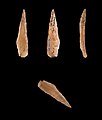Azilien
|
||||
| expansion | ||||
|---|---|---|---|---|
| Central Europe, especially in France | ||||
| Leitforms | ||||
|
The Azilien [ ˈaziːljɜ̃ ] (around 12,300 to 9,600 BC) describes an important culture of the European Upper Paleolithic and the Southern European Epipalaeolithic . The Azilien begins in the Late Glacial and ends with the beginning of the Holocene .
The term was coined by Édouard Piette in 1889 after excavations in the Mas d'Azil cave ( canton Le Mas-d'Azil , Ariège department , France). In the German-speaking world, the Azilien is usually referred to with the synonym " Penknife groups ".
Leading forms are the back knife (also called the back tip, or penknife ) as well as short scratches, burins and harpoons made from deer antlers . The Swiderien runs in parallel in the east.
Azilien was followed by the Mesolithic or Middle Stone Age with the Early Mesolithic (9600-7000/6500 BC) followed by the Late Mesolithic (around 7000 / 6500-5500 / 4500 BC).
literature
- Claude Courad: L'Art Azilien. Origine - survivance. Paris 1985.
- Michael Baales : Between cold and warm. In: W. Menghin (Ed.): People Times Spaces. Archeology in Germany. Berlin 2002.
Web links
Individual evidence
- ↑ M. barbaza: Les Civilizations postglaciaires. La vie dans la grande forêt tempérée , Histoire de la France préhistorique, La Maison des Roches, Paris 1999, 128 pp., 76 ills.



